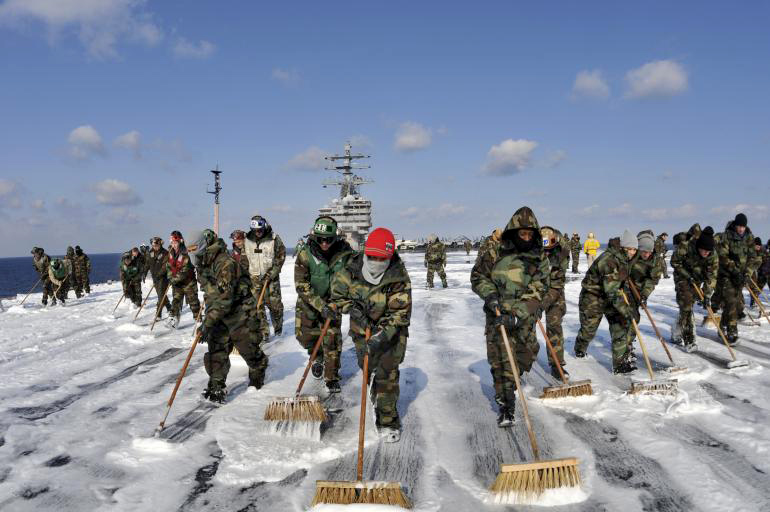It’s no great surprise that the Pentagon does not believe that its Marines and sailors—many of them from Seattleland—were hit with life-threatening illness after pitching in to help the Japanese three years ago this week. That was March 11, 2011, the day that put the fuk in Fukushima.
This is, after all, the Pentagon that experiments on its troops with drugs and vaccines, tested mustard gas on soldiers and nerve gas on sailors, and denied the existence of Agent Orange and Gulf War Illness even as the bodies stacked up.
So when the Navy insists the sailors aboard the USS Ronald Reagan were not at risk and that all necessary precautions were taken, you have to look to history, and then to the odd-tasting snow that fell on the Reagan’s 1,000-foot flight deck that day off the east coast of Japan.
Some of the super-carrier’s crew remember the flakes leaving a metallic taste on their lips. Navy chopper crews, setting down from rescue and supply missions to aid Japanese stranded by the devastating earthquake, tsunami, and meltdown of the Fukushima nuclear power plant, also complained of sensing metal in their saliva.
It was similar to the metallic taste experienced by the crew of the Enola Gay 66 years earlier when their B-29 bomber flew over the radioactive cloud they created by dropping the first atomic bomb on Japan. With a major difference.
The Hiroshima and Nagasaki bombs released an estimated one million curies of radiation that led to widespread illness and deaths, many related to thyroid disease and leukemia. But the human exposure to the Fukushima meltdown is being compared to the 1986 Chernobyl nuclear disaster that released as many as 50 million curies. Chernobyl is predicted to eventually result in tens if not hundreds of thousands of early deaths.
The 3/11 snowfall was the beginning of Japan’s nuclear winter. And the radioactive iodine taste in their mouths was the Reagan crew’s first lesson about radiation. They next learned over the ship’s loudspeaker that they were not to drink or bathe in the ship’s contaminated desalinated sea water. Then they found out their carrier was so hot that that South Korea, Guam, and even Japan barred it from entering their ports.
After returning to its home base in San Diego, the nuclear-powered carrier sailed on to Puget Sound the following January, 2012, for a scheduled 14-month overhaul at the Bremerton Navy yard. There is a report, citing shipyard workers, that carrier hardware contaminated by the Fukushima exposure was taken away on rail and buried on the Hanford N-reservation.
Sailors and Marines began to complain of unexplained cancers, thyroid problems, excessive bleeding, and a litany of other ailments they feel are related to the exposure, estimating that the ship came within five miles of the Japan coast. One sailor’s baby was born with multiple deformations seven months after Fukushima.
No one seemed to be listening to servicemen such as Petty Officer 3rd Class Daniel Hair, who told Stars and Stripes about his pain, memory loss, ringing in the ears, and an immune-system disease so severe he was separated from a Navy job he loved. Fuk-ed over, he said, “I went from this guy in top physical condition to a deteriorating body and a whacked-out mind-set.”
But he and 80 other crew members now have a voice in federal court. “We represent a number of sailors from Everett and also from Bellevue,” says their mouthpiece, Paul Garner, who, with co-counsel Charles Bonner, is an attorney based in Sausalito, Calif. Last month they filed a lawsuit for damages against the allegedly negligent power-plant operator. They seek to establish a $1 billion healthcare fund for affected servicemembers.
Garner says nuke owner Tokyo Electric Power “was fully aware that the American responders would be exposed to hazardous levels of radiation, yet did not communicate this to the ships and to other responders.” (An independent Japanese commission also found that plant operators were unprepared for an accident and that “the direct causes . . . were all foreseeable.”)
A copy of the federal suit also shows Navy plaintiffs from Mount Vernon and Bremerton, and more of the Reagan’s crew of 5,500 are expected to sign on, along with some civilians. “The workers at Bremerton who worked on the decontamination of the Reagan have also reportedly come down with illnesses,” Garner tells me.
In addition to the suit, Congress has now asked the Pentagon to review the exposure and report back next month. Meanwhile, the Navy’s denials of harm are being knocked down. One new study of 3/11’s effects, reported in The Asia-Pacific Journal, pegs radiation levels aboard the carrier at 30 times above normal.
The report includes a transcript of a telephone conversation with a U.S. Energy Department administrator—the guy in charge of Navy reactors—who describes the Reagan’s radiation level as “much greater than what we had thought.” Some sailors, he tells another official, could have suffered irreversible harm within hours: “It’s a thyroid dose issue.”
At last, “It feels like maybe there’s light at the end of the tunnel,” says attorney Garner. “But we shall see.”
randerson@seattleweekly.com
Rick Anderson writes about sex, crime, money, and politics, which tend to be the same thing.








